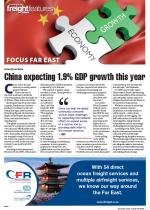The Far East will remain one of the most dynamic and important regions for logistics, despite a shift into other Asian countries. This is according to Jana Schebera, managing director of Tigers China, who says China is fast turning into the biggest global economy and its demand for import logistics and domestic logistics services will remain buoyant.“The relocation of industry away from China into other parts of Asia, however, is pushing demand for intracontinental logistics which can be tackled through various solutions by sea, air and land. In reaction to this trend the capacity for exports out of other parts of Asia – such as Vietnam – has been unable to fully keep pace and further investment in infrastructure and additional capacity is needed.”Schebera said there was increasing demand for exports into Africa from the Far East, but capacity constraints remained problematic.“For destination services or to serve some of the landlocked countries, the high level of logistics cost and lack of options is a real showstopper. Apart from a few regional hubs, such as South Africa and Kenya, logistics in Africa remains prohibitively expensive, choking off many trade opportunities.”Paul Lawrence, managing director of Tigers South Africa, said two of the biggest challenges facing operators from a China-South Africa perspective were space and equipment shortages. “We have also seen dramatic increases in freight rates over the past few months,” he said. “The current rates have in some cases more than trebled from the beginning of 2020. We believe this will continue for as long as there are space and equipment shortages. The same can be said for airfreight capacity due to very few passenger planes f lying into South Africa at present. There is also a limited number of freighters – and the airfreight rates have risen significantly.”According to Lawrence, during the height of the Covid-19 outbreak, when demand for personal protective equipment (PPE) was high, rates more than quadrupled from China.“This, in turn, puts pressure on local businesses to remain competitive, and there has been a big drive for companies to support locally produced products wherever possible.”Schebera said markets around the world were facing exceptional situations due to the Covid-19 outbreak.“We are confronted with extreme logistics bottlenecks and an overall tightness of capacity and logistics labour. We have had to become creative in offering our customers better solutions to overcome their supply chain challenges.”She said the company was tapping into all modes of transportation besides the standard air and ocean modes – including rail-truck, sea-truck and intercontinental truck from China into the Americas and Europe – to get customers’ cargoes delivered to destinations on time.“We are also seeing a substantial increase in demand for B2C logistics which we’re meeting by expanding our facilities and setting

